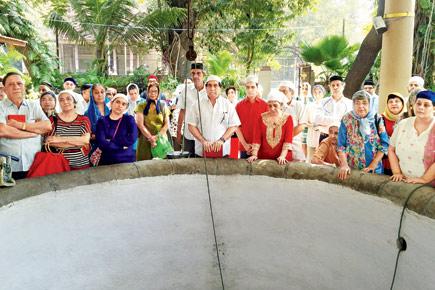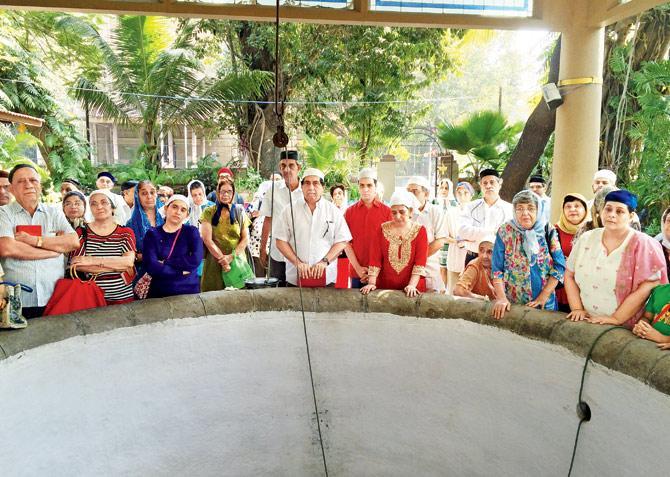Tunnel dug for project will deplete sweet, holy water, fear trustees; authorities respond, promise meeting to allay fears

The Bhikha Behram Well, one the city's oldest sunken sweet water sources, Grade I heritage structure and holy to the Parsis, near Cross Maidan and Churchgate, may be threatened by the Metro Rail Line 3 plan. There is some trepidation that the digging of the tunnel, for the Metro Rail Line 3, may drain out water from the sub-soil completely.
ADVERTISEMENT

Around the well, the air is filled with piety and reverence and a serenity that has prevailed for close to 300 years
This well was built in 1725 by Bhikha Behram to thank the almighty for sparing his life after the Marathas who were at war with the Sultans of Gujarat mistook him for a Muslim, (he showed his sureh-kusti and was finally set free).
It is one of the few Parsi wells in the city, which has one entrance for community members and another for non-Parsis to draw water.
With a rich history, it has a strong sentimental pull for the community, as well as of course, great religious significance. Now, the trustees of the well have raised significant concerns that the proposed Mumbai Metro Rail Line 3 is going to pass very close to the holy well. Subsequently, they say that the depth of the well water will be adversely affected, as there is going to be excavation for the Metro 3 line. They commissioned Dr Rama Krishna, Powai geologist, to conduct an investigation report. Says Dr Krishna, “I made an investigative report, about 1.5 months ago. I had concerns because the digging for the tunnel of the metro line was going to be around 12 - 18m. Though the central line of excavation would pass about 50 ft (15 m) from the well, it will affect the well. There is bound to be a drop in the water level.”
Dr Krishna buttresses his argument by citing that when the Metro subway was being constructed, “I was called to study the effect of the water level in the Dhobi Talao area. There is substantial water in that area. There were a number of pumps installed in the vicinity to pump out the water. It did affect the water level of several wells there. While the BMC could replace that shortfall, it is not possible to replace the holy water in Bhikha Behram Well.” Dr Krishna ended that, “in the report, we have suggested that the Metro-3 line be shifted away from the Churchgate-Cross Maidan side and towards the Oval Maidan.”
The big two H's here are holy and heritage, but, the community says the well is also symbolic of the legendary Parsi philanthropy to the city. Burjor Antia, chairman, Bhikha Behram Board of Trustees, says, “People from the Fort area use this water to slake their thirst, and for office use. This is charity of water for everyone.” That is why Antia states that, “it is not just the Parsi community, but everybody who has a stake here and must be concerned about the proposed line.” Antia reminisced about the old days, “In the 1940s, when families like the Mafatlals used to take water from the well, in pipe drums.”
Explaining that the trustees have asked the metro authorities for a meeting, Antia adds, “this is a legal process and we are waiting to hear from them.”
Bikha Behram Well trustee, Homiar Vakil states, “There is great anxiety. This well has never dried up since 300 years. If anything happens to this well, it can never be replaced.”
RITES, a government consultancy agency had done the Environment Impact Assessment (EIA) study for the underground Colaba Bandar Seepz (CBS) metro line 3 project which is being implemented by Mumbai Metro Rail Corporation (MMRC), in January, 2012. This report also mentions this well. A part of the report gives a thumbnail sketch of its historical import, saying 'the well has a perennial source of sweet water, which is remarkable as most of the water in the area is brackish owing to the proximity to the Arabian Sea.” The report states that vibration monitoring was carried out in front of Parsi well.
An MMRC official spoke on request of anonymity, “We have written to the Trustees. We believe after which, they also had a discussion amongst themselves. Soon, we will be having another meeting with them and expect a positive outcome to our ongoing talks.”
There are community members who are keeping the faith though, in the power of the well and the Govt. Says Hoshaang Gotla, who has been conducting a prayer every month at the Bhikha Behram Well, “it has been a tradition for 6.5 years,” he explains. “the prayer is held monthly, on a day representing water called, 'Ava'. The prayer itself is called, 'Humbandagi' which literally means praying together and it is held because we believe that the community which prays together, stays together,” says Gotla, who is an executive assistant to the MD of Hiranandani Group. Gotla believes that while the trepidation is natural, “I know the Govt. will take care of the religious sentiments of the community and I have full faith that no harm will come to this well.”
 Subscribe today by clicking the link and stay updated with the latest news!" Click here!
Subscribe today by clicking the link and stay updated with the latest news!" Click here!






